Food delivery services have witnessed a massive surge in demand over recent years. According to a report from Statista, the global online food delivery market is projected to reach $154.34 billion by 2023. However, with this growth comes a growing concern: order cancellations. A report by the National Restaurant Association indicates that food delivery apps platforms have seen cancellation rates ranging from 15% to 30%. These cancellations lead to financial losses for restaurants, delivery partners, and the platforms themselves.
The reasons behind canceled orders can range from logistical challenges to payment-related issues. Fortunately, modern solutions offered by food delivery app development companies can address these problems by improving operational efficiency, enhancing customer experience, and ensuring smoother payment processing.
Table of Contents
The Importance of Logistics in Reducing Canceled Orders
Effective logistics management plays a crucial role in the success of food delivery services. Logistics encompasses all the processes involved in getting the food from the restaurant to the customer’s doorstep. When these processes fail or are delayed, it directly impacts the likelihood of order cancellations. Let’s look at how food delivery app development companies can improve logistics to reduce canceled orders.
1. Optimizing Delivery Routes
One of the primary causes of delays in food delivery is inefficient route planning. Inaccurate or outdated maps, heavy traffic, or unexpected roadblocks can cause drivers to take longer routes, which leads to longer delivery times. The more delayed the order is, the higher the chances of a cancellation.
Solution: Food delivery apps can use real-time GPS and artificial intelligence to optimize delivery routes. By integrating advanced mapping tools and traffic monitoring systems, delivery drivers can follow the quickest routes available. This not only reduces delivery times but also helps ensure food arrives hot and fresh, enhancing the customer experience.
2. Predictive Analytics for Demand Forecasting
Another significant logistical challenge for food delivery apps is accurately forecasting demand. Without proper demand prediction, apps may suffer from supply shortages or overstaffing, both of which can lead to order delays or cancellations.
Solution: By utilizing predictive analytics, food delivery apps can better anticipate peak times and adjust the number of drivers available accordingly. Predictive analytics takes into account factors like historical data, customer preferences, weather conditions, holidays, and local events. By optimizing driver schedules based on these insights, food delivery apps can ensure orders are fulfilled promptly.
3. Improving Delivery Partner Coordination
A lack of clear communication and coordination between restaurants, delivery drivers, and customers often leads to confusion and cancellations. If delivery partners are unable to find the restaurant or reach the customer on time, the likelihood of canceled orders increases.
Solution: Food delivery app development services can create platforms that allow seamless communication between all parties. Features like real-time order tracking, in-app messaging, and notifications can help delivery drivers stay updated on the status of their deliveries. In turn, customers can track their orders and know exactly when to expect their food, which helps reduce frustration and cancellations.
4. Better Restaurant-Delivery Integration
The interface between restaurants and delivery drivers plays a critical role in the overall logistics of the service. Restaurants that are slow to prepare orders or fail to update the status of an order in real-time can cause delays in the system, resulting in order cancellations.
Solution: Modern food delivery apps can help reduce these issues by integrating restaurants’ point-of-sale systems with the app. This integration can instantly update the status of orders, allowing delivery drivers to be notified as soon as an order is ready for pickup. This system minimizes waiting times at the restaurant and reduces the chances of cancellations due to delays.
Improving Payment Systems to Reduce Canceled Orders
Payment failures are another leading cause of order cancellations. When customers face issues with payment, whether it’s due to technical glitches or failed transactions, they may cancel their orders. Therefore, addressing payment-related issues is essential for minimizing order cancellations.
1. Multiple Payment Options
Many customers prefer flexibility when it comes to payment methods. Restricting payment options can lead to abandoned carts and cancellations. If an app only accepts one or two forms of payment, such as credit cards or cash on delivery, it limits the convenience for customers who may prefer alternatives like mobile wallets, UPI, or online banking.
Solution: Food delivery app development companies should offer multiple payment options within their platforms. Integrating widely used payment methods like Google Pay, Apple Pay, PayPal, or even cryptocurrency can cater to a broader range of customers. This flexibility ensures that customers can complete their purchases without encountering payment issues, reducing the likelihood of cancellations.
2. Seamless Payment Processing
A common problem faced by food delivery apps is payment failures or delays in payment processing. These can occur due to a variety of reasons, such as network errors, insufficient funds, or card authorization failures. When these issues arise during the checkout process, customers may opt to cancel their orders in frustration.
Solution: Implementing secure, real-time payment gateways can significantly reduce payment failures. By integrating advanced fraud detection and prevention mechanisms, food delivery apps can ensure secure and smooth transactions. Additionally, offering real-time transaction status updates and transparent payment processing can improve customer trust and minimize cancellations.
3. Offering Incentives for Successful Payments
Sometimes, customers abandon their orders due to concerns about hidden charges or unclear pricing. Additionally, customers may worry about the potential for payments to fail after their orders have been placed.
Solution: Food delivery apps can reduce order cancellations by offering transparent pricing and clear billing information upfront. Furthermore, incentivizing customers with discounts or loyalty rewards for completing their orders successfully can boost payment completion rates. By providing customers with a reason to follow through with their orders, apps can decrease the chance of cancellations.
4. Automated Payment Recovery
Failed or declined payments can lead to delayed or canceled orders if not addressed quickly. To prevent this from happening, food delivery apps can integrate automated payment recovery systems.
Solution: When a payment fails, the system can automatically notify customers and offer them an easy way to retry or select an alternative payment method. Automated reminders, personalized messages, and a simple user interface can help customers complete their transactions, reducing the risk of cancellations.
How Data and Analytics Can Improve Both Logistics and Payments
To truly minimize canceled orders, food delivery platforms must adopt a data-driven approach to both logistics and payments. Collecting and analyzing data from every stage of the delivery process can provide insights into areas that need improvement.
1. Monitoring Delivery Times
By tracking delivery times across different regions and times of day, food delivery platforms can identify where delays are happening. For example, if certain areas experience traffic congestion regularly, adjustments can be made to delivery routes.
Solution: Data-driven insights can allow apps to proactively adjust delivery schedules, better allocate resources, and improve logistics efficiency, ultimately reducing canceled orders.
2. Analyzing Payment Patterns
Payment data can reveal patterns related to failed transactions or order cancellations. By identifying common causes of payment failures, such as particular payment methods or locations, food delivery apps can improve the payment experience.
Solution: Platforms can adjust their payment systems based on these findings, offering additional options or improving fraud detection mechanisms in specific areas.
3. Customer Feedback and Satisfaction
Customer feedback, if collected and analyzed, can provide a wealth of information about potential issues in the ordering process. If customers consistently report slow deliveries or issues with payment methods, those areas can be addressed systematically.
Solution: Integrating feedback mechanisms into food delivery apps can help gather customer insights and ensure that problems are resolved quickly, reducing cancellations in the long run.

Conclusion:
Order cancellations in food delivery apps are a significant challenge, but they can be mitigated through a strategic focus on both logistics and payments. By optimizing delivery routes, improving restaurant coordination, offering flexible payment methods, and leveraging data-driven solutions, food delivery apps can reduce the likelihood of cancellations.
If you’re looking for a reliable food delivery app development company to build a robust solution for your business, partnering with experienced developers is key. HashStudioz, a leading food delivery app development company, offers tailored food delivery app development services that tackle logistical challenges, streamline payment processes, and reduce cancellations. By implementing the right technology and strategies, you can provide an exceptional user experience and reduce order cancellations significantly.
To learn more about our innovative solutions, contact HashStudioz today and take the first step toward transforming your food delivery business!

